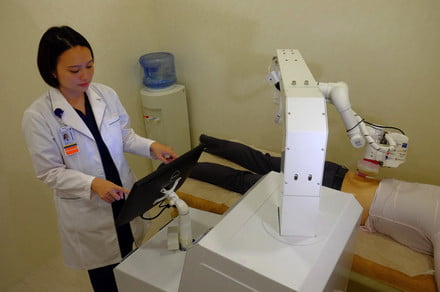Why it matters to you
A new smart robot masseuse is designed to give you the perfect massage every single time.
What better way to unwind following a busy day on the unemployment line — after having your job stolen by a machine, no less — than with a nice, soothing massage? And what better way to ensure that your massage is exactly how you always like it than by getting a robot to do it? That’s now possible, courtesy of a new robo-masseuse that just started work in Singapore.
Called Expert Manipulative Massage Automation — or Emma, for short — the robot specializes in back and knee massages. It is the third Emma model developed, but the first to be deployed in the real world. Emma works by using smart sensors to work out how stiff particular muscles and tendons are, and then figuring out how much pressure needs to be applied to that area.
“This is the first therapeutic massage robot in the market, actually working to give therapeutic massages to real patients at a pain-management clinic, such as those operated by traditional Chinese medicine physicians,” Albert Zhang, founder of the Singaporean startup AiTreat and inventor of Emma, told Digital Trends. “Patients who have tried Emma don’t find much difference between Emma and a human masseuse, because Emma’s soft silicon tips are heated and shaped similar to the human thumb and palm. It is also able to give a massage with consistent strength and accuracy, something which varies between human masseuses, who are also affected by fatigue.”
Despite our quip about replacing human masseuses, Emma’s inventor thinks that it will have a place working alongside humans — for now — since it can help to free up human experts to concentrate on other forms of treatments, such as neck and elbows massages. “One of the hardest challenges we faced was to replicate some of the massage techniques used by a professional masseuse in traditional Chinese medicine,” Zhang said. “Each masseuse has their own style of massage, and we had to program Emma to mimic them as best as she could — delivering enough strength to penetrate the muscles to relax them, but yet not too painful for the patient.”
At present, Emma is working at a health clinic in the Central Business District in Singapore. The clinic rents Emma for around $2,200 per month, which is similar to the average pay of a masseuse in Singapore. While that may seem a lot for a machine that can only carry out a fraction of what a human masseuse can do, it could be worth it if it means more patients come through the door.
Our biggest question in all this? When robots inevitably form the majority of the workforce, and wear themselves out accordingly, will robot-on-robot massages become a thing? After all, robots can have muscles, too.

